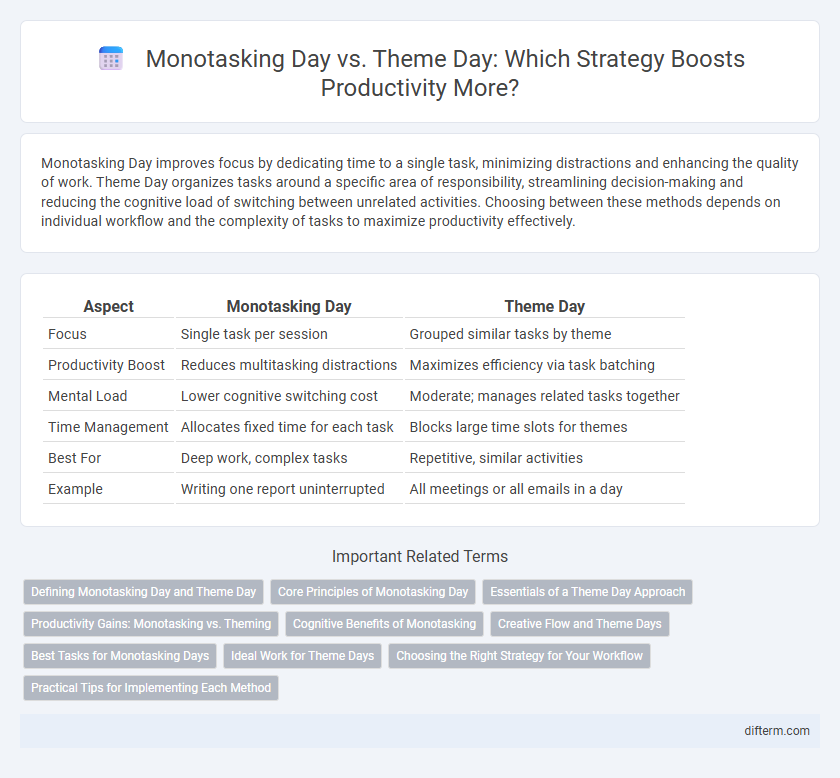Monotasking Day improves focus by dedicating time to a single task, minimizing distractions and enhancing the quality of work. Theme Day organizes tasks around a specific area of responsibility, streamlining decision-making and reducing the cognitive load of switching between unrelated activities. Choosing between these methods depends on individual workflow and the complexity of tasks to maximize productivity effectively.
Table of Comparison
| Aspect | Monotasking Day | Theme Day |
|---|---|---|
| Focus | Single task per session | Grouped similar tasks by theme |
| Productivity Boost | Reduces multitasking distractions | Maximizes efficiency via task batching |
| Mental Load | Lower cognitive switching cost | Moderate; manages related tasks together |
| Time Management | Allocates fixed time for each task | Blocks large time slots for themes |
| Best For | Deep work, complex tasks | Repetitive, similar activities |
| Example | Writing one report uninterrupted | All meetings or all emails in a day |
Defining Monotasking Day and Theme Day
Monotasking Day involves dedicating uninterrupted time to a single task, enhancing deep focus and minimizing distractions for maximum productivity. Theme Day organizes work by grouping similar tasks or projects, promoting efficiency through task batching and contextual engagement. Both strategies aim to optimize workflow but differ in their approach to task management and attention allocation.
Core Principles of Monotasking Day
Monotasking Day centers on the core principle of dedicating uninterrupted time to a single task, minimizing distractions to enhance concentration and efficiency. This approach contrasts with Theme Day, which groups similar tasks but may still involve switching between assignments. Focusing on one task at a time fosters deeper cognitive engagement, reduces mental fatigue, and significantly boosts overall productivity.
Essentials of a Theme Day Approach
Monotasking Day emphasizes completing one task at a time, enhancing deep focus and reducing cognitive switching costs. Theme Day prioritizes grouping similar tasks or objectives, aligning activities around a central theme to maximize productivity and mental flow. This thematic approach reduces decision fatigue and fosters sustained engagement by leveraging task similarity and contextual consistency.
Productivity Gains: Monotasking vs. Theming
Monotasking Day enhances productivity by encouraging focused attention on a single task, reducing cognitive switching costs and improving deep work quality. Theme Day organizes work around specific categories or project types, facilitating structured progress through related activities and minimizing decision fatigue. Both approaches boost productivity, but monotasking excels at maximizing concentration spans, while theming optimizes workflow alignment with broader objectives.
Cognitive Benefits of Monotasking
Monotasking enhances cognitive function by reducing mental fatigue and improving sustained attention, allowing deeper processing of information during work sessions. Research shows monotasking Day boosts working memory capacity and decreases cognitive switching costs compared to multitasking or scattered efforts on Theme Day. Prioritizing single-task focus promotes neuroplasticity and efficient brain resource allocation, leading to heightened productivity and creativity.
Creative Flow and Theme Days
Theme Days enhance creative flow by allocating dedicated time blocks to specific project categories, reducing cognitive switching costs. Monotasking Day emphasizes singular task focus but may limit broader thematic immersion necessary for complex ideation. Embracing Theme Days supports sustained creative momentum and deeper domain engagement, optimizing productivity in innovation-driven workstreams.
Best Tasks for Monotasking Days
Monotasking days are best suited for deep work tasks that require intense concentration, such as complex problem-solving, creative writing, or coding. These tasks benefit from uninterrupted focus, allowing the brain to enter a state of flow and produce higher quality output with greater efficiency. Prioritizing single high-impact activities on monotasking days maximizes productivity by minimizing context switching and cognitive overload.
Ideal Work for Theme Days
Theme days enhance productivity by dedicating specific days to particular types of work, allowing deep focus and minimizing task-switching. Ideal work for theme days includes complex projects requiring sustained concentration, such as strategic planning, creative brainstorming, or intensive analysis. This approach aligns with cognitive best practices, reducing mental fatigue and boosting overall work quality.
Choosing the Right Strategy for Your Workflow
Monotasking Day emphasizes deep focus by dedicating time to a single task, reducing cognitive switching costs and enhancing concentration. Theme Day organizes work around related activities, promoting thematic flow and aligning tasks to mental energy cycles for heightened efficiency. Selecting the right strategy depends on task complexity, personal energy rhythms, and the need for sustained attention or varied cognitive engagement.
Practical Tips for Implementing Each Method
Monotasking Day involves dedicating uninterrupted blocks of time to a single task, enhancing concentration and reducing cognitive switching costs; practical tips include scheduling specific time slots, minimizing distractions by turning off notifications, and setting clear goals for each session. Theme Day allocates entire days to related tasks or projects, promoting deep immersion and thematic focus; to implement effectively, organize the calendar by categorizing work types, batch related meetings or tasks, and prepare necessary resources in advance to streamline workflow. Both methods benefit from regular reviews to assess productivity gains and adjust time allocations accordingly.
Monotasking Day vs Theme Day Infographic

 difterm.com
difterm.com